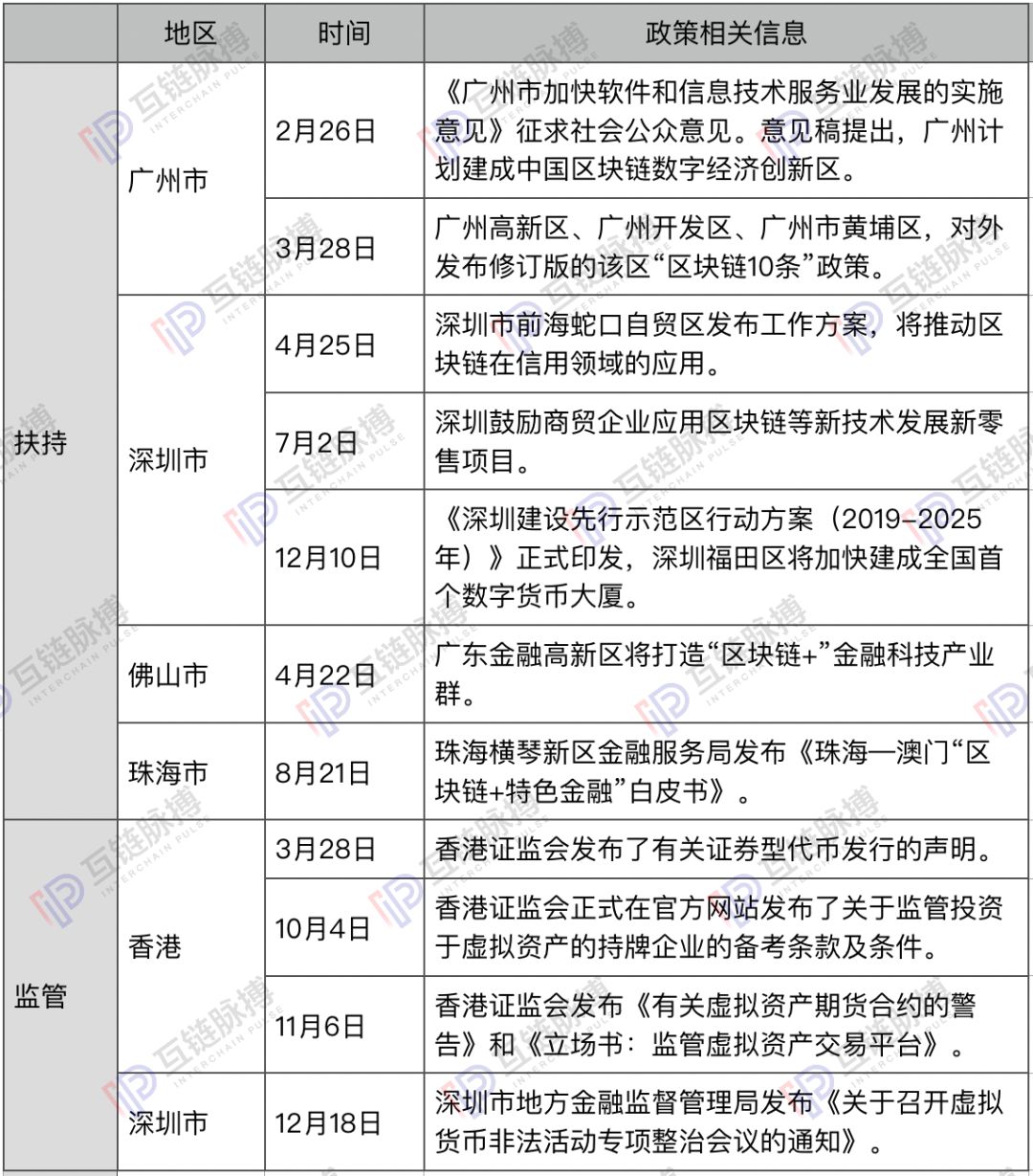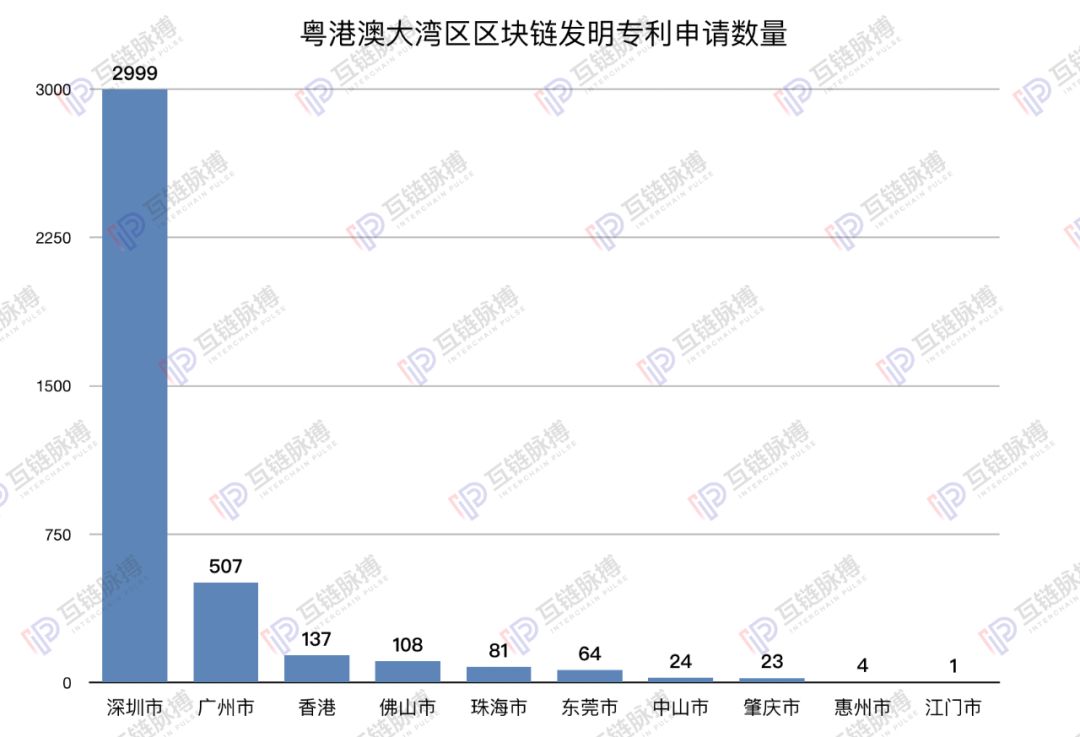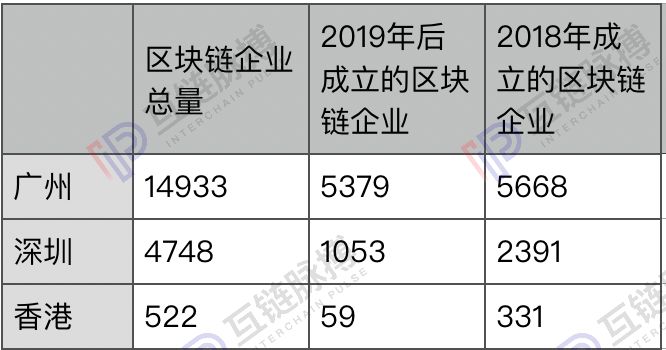Anniversary of the planning of the Greater Bay Area: Guangdong, Hong Kong and Macau have become a treasure trove of blockchain development
Text 丨 Interlink Pulse · Golden Walk
[Interlink Pulse Press] On February 18 last year, the "Outline of Development Planning for the Guangdong-Hong Kong-Macao Greater Bay Area" (hereinafter referred to as the "Planning Outline") was officially released, just one year ago. During this year, the development results of the Greater Bay Area blockchain have begun to show, and further promoted the interconnection, cooperation and development of Guangdong, Hong Kong and Macao. Interchain Pulse launched the Bay Area Blockchain Industry Topic in February 2019. On the first anniversary of the construction of the Bay Area, the pulse of the inter-chain has analyzed the development of the blockchain in Guangdong, Hong Kong, and Macao from three dimensions: policy, scientific research, and industrial application.
One year ago, the Guangdong-Hong Kong-Macao Greater Bay Area planning outline was released, and the construction of the Greater Bay Area officially rose to the national strategy. The Bay Area has 9 cities with world-leading industrial structures, but it has three systems. Coordinated development is not easy. The simple blockchain is a technical solution to coordinated development. On November 25 of last year, Chen Lei, CEO of Thunder Group and CEO of Wangxin Technology, stated at the Second Guangdong-Hong Kong-Macao Greater Bay Area Financial Development Forum that blockchain and related technologies can help build an efficient, orderly and credible financial system. , Will become the core technology of the Guangdong-Hong Kong-Macao Greater Bay Area top-level design.
One year after the release of the planning outline, the development of the blockchain in the Guangdong-Hong Kong-Macao Greater Bay Area has indeed led the trend.
- Morgan Stanley acquires crypto-friendly brokerage firm E * Trade for $ 13 billion
- Views | Oscar nominations have repeatedly been criticized, blockchain may change the status quo
- Blockchain war "epidemic" is on its way, 20 applications have landed
Greater Bay Area Blockchain Policy: Guangzhou Support Leads Hong Kong Regulatory Guidance
After the planning outline was officially released, the Greater Bay Area has successively introduced a series of blockchain policies, which are relatively supportive and have a relatively small regulatory proportion.
In February 2019, Interchain Pulse also sorted out the blockchain policy information in Guangdong, Hong Kong, and Macau, and summarized the severity of the blockchain regulatory measures in the three regions: Guangdong> Hong Kong> Macau.
But this order has changed in the past year. Compared with Guangdong, Hong Kong's supervision of the blockchain sector is more prominent. In 2019, the Hong Kong Securities Regulatory Commission has gradually promoted the supervision of securities token issuance (STO), licensed virtual asset managers, and virtual asset futures contracts and virtual asset trading platforms. These regulations are essentially guiding the healthy development of the blockchain field, and have certain promotion significance for the positive development of the industry.
In addition to Hong Kong, Shenzhen has also introduced corresponding regulatory measures. After the blockchain was listed as an "important breakthrough in independent innovation of core technology" at the end of October, the blockchain market reacted strongly and, at a time when fish and fish were mixed, the Shenzhen Local Financial Supervision Administration also strengthened supervision and launched illegal virtual currency activities Special rectification.

(Tabulation: interlink pulse)
Compared with supervision, Guangdong, Hong Kong and Macao regions paid more attention to the support of the blockchain field during this year. Prior to this, the Guangdong-Hong Kong-Macao Greater Bay Area was a region with a high density of blockchain support policies. In the past year, Guangzhou and Shenzhen in Guangdong have contributed a lot of "voice" in the support of blockchain.
And the mutual chain pulse observes that the supporting policies of the Greater Bay Area cities have two characteristics:
The first is to promote blockchain industrial clusters, and currently there are multiple industrial clusters in the Greater Bay Area. The current blockchain industry clusters are: China's Blockchain Digital Economy Innovation Zone in Guangzhou; the "Blockchain +" fintech industrial cluster created by the Guangdong Financial High-tech Zone in Foshan; the first digital currency building in China will be built Futian District, Shenzhen; Zhuhai and Macao jointly released the white paper "Blockchain + Featured Finance".
Second, during this year, the Greater Bay Area increased its funding support for the blockchain field.
In March 2019, the “Blockchain 10 2.0” in Huangpu District of Guangzhou was released. The policy strengthened financial support capabilities, encouraged the establishment of a 1 billion-scale blockchain industry fund, and attracted social capital to form a capital supply effect. Later in April, Guangdong Financial High-tech Zone will build a "blockchain +" fintech industry cluster base, focusing on identifying "blockchain +" fintech companies. Approved enterprises can receive a maximum of 1.3 million yuan in settlement rewards; in July, the "Shenzhen Commercial Bureau's Industrial Development Special Fund Consumption Promotion Support Plan Operation Regulations" was officially issued. Shenzhen encourages business enterprises to apply new technologies such as blockchain to develop new retail projects, and grants 20% of the actual investment amount to eligible markets and projects.
In summary, the blockchain policy of the Guangdong-Hong Kong-Macao Greater Bay Area this year, of which Hong Kong paid more attention to the positive guidance of the blockchain field in the form of supervision; the blockchain in Guangdong strengthened the formation of industrial clusters. And increase funding support; there are currently few blockchain related policies in Macau.
Bay Area blockchain scientific research continues to advance Shenzhen's number of patent applications
On the basis of policy development, the blockchain research work in the Guangdong, Hong Kong, and Macau Greater Bay Area is also continuing to advance. Previously, blockchain research centers and laboratories in Guangdong, Hong Kong, and Macau were widely distributed in Guangzhou, Shenzhen, Macau, Hong Kong, Dongguan and other regions. According to the statistics of the mutual chain pulse, during the year of the Bay Area construction, the newly established blockchain research institutions were relatively concentrated in Shenzhen and Hong Kong.
In June 2019, Xunlei Group and the Hong Kong University of Science and Technology established a joint laboratory, which aims to develop influential and cutting-edge blockchain technology and applications for various industries; in December, Hong Kong International The New Economic Research Institute announced the formal establishment of the Digital Economy Research Center; Li Qing Chain Technology, a subsidiary of Zhongqingbao Holdings, and the Shenzhen Research Institute of Nankai University, also established the “Blockchain Research Center of Shenzhen Research Institute of Nankai University” at this time.
In October 2019, Shenzhen established the first industrial college, Shenzhen University Weizhong Bank's Financial Technology College, which has professional orientations such as blockchain finance.

(Tabulation: interlink pulse)
On the basis of research institutions, Interchain Pulse further focuses on the research results of the blockchain, and observes the research results of the blockchain in the Greater Bay Area through the application volume of blockchain invention patents.

(Drawing: Interlink Pulse Source: innojoy, Hong Kong Intellectual Property Department)
According to innojoy data, as of now, Guangdong Province has a total of 3829 blockchain invention patents, ranking first in the country, and among them, 1499 blockchain invention patents have been applied for since February 18, 2019. Blockchain patents promoted after the release of the planning outline accounted for 39.14% of the total.
Among them, Shenzhen currently has a total of 2999 blockchain invention patents, and 1293 have been applied for since the planning outline was issued, accounting for 43.11% of the total; Guangzhou has a total of 507 patents, of which 151 items are in the planning outline Apply after posting. At the same time, according to the official website of the Hong Kong Intellectual Property Department, there are currently 137 blockchain invention patents in Hong Kong, of which 51 were announced after the planning outline was issued.
Overall, during the year, the number of blockchain patent applications in the Guangdong-Hong Kong-Macao Greater Bay Area did not grow explosively as in 2018, but slowed down. But among them, the number of blockchain patent applications in Shenzhen has increased steadily.
Previously, in December 2019, the "Public Entrepreneurship, Innovation for Everyone" study (2019)-Guangdong, Hong Kong, and Macao, released by the research group led by Counsellor of the State Council, Wang Jingsheng, member of the expert group of the Coordination Group of the State Council to promote the transformation of government functions and the "decentralized service" reform coordination team The Greater Bay Area Innovation Report has also shown that Shenzhen is the first in major cities across the country in terms of cumulative disclosure of PCT international patent applications such as blockchain technology.
Guangshen leads the landing of the blockchain, the landing point is in the field of government affairs
Based on the development of policies and scientific research, the blockchain industry in the Guangdong-Hong Kong-Macao Greater Bay Area has also achieved further development.
Mutual Chain Pulse first focused on blockchain companies in the Bay Area. Through the enterprise search, we searched according to the scope of business and the name of the company, including "blockchain". Up to now, there are a total of 20,602 enterprises with blockchain as the scope of business in Guangdong Province, of which 6,820 are established after 2019, but Prior to 2018, there were 8,436 blockchain companies established in a single year.

(Tabulation: inter-chain pulse data source: enterprises check)
It can be seen from the statistical data that compared to the explosive growth of blockchain companies in various places in 2018, after the publication of the "Outline", blockchain growth has been slower, but in fact Guangdong, Hong Kong, and Macao regions still attract many blockchain companies, and Some companies have relocated their technology research and development to the Greater Bay Area.
For companies with higher migration costs, the Greater Bay Area also provides corresponding solutions. In June 2019, Fu Ming, deputy director of the Guangdong-Hong Kong-Macao Greater Bay Area Blockchain Alliance and deputy chairman of the Guangzhou Blockchain Entrepreneurship Association, revealed that the Guangdong-Hong Kong-Macao Greater Bay Area will build a blockchain offshore incubator model to solve enterprises. Difficulties in obtaining blockchain development policy problems in the Guangdong-Hong Kong-Macao Greater Bay Area. Blockchain companies that have not settled in the Guangdong-Hong Kong-Macao Greater Bay Area in the future will also have the opportunity to enjoy the policies and conveniences of the Greater Bay Area.
Previously, Interchain Pulse had concluded that Hong Kong is more concentrated in blockchain capital, and Shenzhen is a gathering place for blockchain companies, blockchain technology, and blockchain applications; Guangzhou is hosting more blockchain incubation Institutions, training institutions, industry associations, alliances; Macau is mainly responsible for hosting blockchain activities. With the development of these institutions and enterprises, the mutual chain pulse pays attention to the development of blockchain applications in the Guangdong-Hong Kong-Macao Greater Bay Area.
In the past year, blockchain applications have been relatively concentrated in Shenzhen and Guangzhou, and applications have been relatively concentrated in government affairs.
Shenzhen has gathered leading Internet companies such as Tencent, Huawei, and Thunder, and is also the seat of the Central Bank's Digital Currency Research Institute. As the nation's first blockchain electronic invoice pilot city, the most important application of blockchain in Shenzhen is in the tax field in government affairs.
In October 2019, the blockchain electronic invoices have been connected to more than 7,600 enterprises, the number of invoices has exceeded 10 million, and the amount exceeds 7 billion yuan, serving hundreds of industries such as financial insurance, retailer supermarkets, and parking services. At the end of the year, the number of Shenzhen block chain electronic invoices exceeded 14 million. Electronic invoices are fully promoted in Shenzhen Qianhai as a pilot, and in January 2020, electronic invoices will be fully covered.

(Tabulation: interlink pulse)
In addition, Guangzhou also has applications in the tax field. In October 2019, Guangdong Province officially launched blockchain financial electronic bills. Guangzhou Women's and Children's Medical Center and South China Normal University were the first to issue blockchain financial electronic bills. This is also the first batch of on-chain billing units in Guangdong Province.
However, Guangzhou's blockchain application focuses on judicial and commercial services in the government field, and is mainly led by government agencies.
In September 2019, the Huangpu District of Guangzhou officially launched the "Commercial Service Blockchain Platform", which is a version of the more convenient commercial reform version 3.0 launched on the basis of existing policies. It is understood that Huangpu District ’s first “blockchain + AI” service model for business establishment in the country has created a shared “registration network” based on blockchain technology, and is exploring the realization of commercial services for Hong Kong and Macao enterprises by expanding to Hong Kong and Macao. No entry, offshore processing. " In October, the Huangpu District Market Supervision Bureau of Guangzhou City, six banks including China Merchants Bank, China Construction Bank, and the Guangdong, Hong Kong and Macau Youth Innovation and Entrepreneurship Base operating units respectively issued the first batch of "cross-border" Pass "business license and free seal.
This blockchain application in Guangzhou not only achieves the development of the blockchain field, but also further serves the cooperation between Guangdong, Hong Kong and Macao.
In addition, in August 2019, Guangzhou Haizhu Notary Office adopted the blockchain technology and cloud computing technology to build the first blockchain distributed depository notary system in South China. It is reported that the platform can achieve business synergy with many judicial nodes across the country; in January 2010, the "Guangzhou Public Law Chain" was completed and applied, and the city's appraisal institutions accessed the "Guangzhou Public Law Chain" to implement electronic judicial appraisal opinions for external storage, evidence collection services and A new management model; in the same period, the Guangdong Provincial Financial Supervision and Administration Bureau took the lead and launched a Guangdong SME financing platform.
From this point of view, the blockchain industry in Guangdong, Hong Kong, and Macao is mainly led by Shenzhen and Guangzhou, and has achieved a major breakthrough in the field of government affairs. As a matter of fact, after the programmatic documents for the cooperative development of the Guangdong-Hong Kong-Macao Greater Bay Area were officially released, the focus of blockchain development in each city was different, but cooperation was actively carried out, and the blockchain development landscape was gradually established. In the future, in such a world-class city group, the development of blockchain is worth looking forward to.
We will continue to update Blocking; if you have any questions or suggestions, please contact us!
Was this article helpful?
93 out of 132 found this helpful
Related articles
- Becoming the first crab-eating country, Sweden begins testing e-krona, a digital currency of the central bank based on blockchain
- Lightning Loan: New DeFi Project Gameplay, How to Attack MakerDao for $ 700 Million
- Rational understanding and perceptual practice of blockchain: How to correctly understand blockchain and choose the correct technological development route?
- The court acquiesced that Gram tokens are securities? Telegram's fight against regulation is coming to an end
- Benefits escalate again! Babbitt Industry Orientation Starts Knowledge Officer Program
- The plunge was caused by Binance shorting after losing coins? Let the data on the chain tell you the truth
- Data: Bitcoin investment traffic is expected to exceed Visa after next halving






